Home /
Expert Answers /
Biology /
this-is-a-gram-stain-of-a-sample-of-yoghurt-how-many-different-bacterial-cell-morphologies-are-th-pa768
(Solved): This is a Gram-stain of a sample of yoghurt. How many different bacterial cell morphologies are th ...
This is a Gram-stain of a sample of yoghurt. How many different bacterial cell morphologies are there?
Below is averaged class data collected for the Hand Hygiene experiment from a previous year. Remember that there are 3 sections on your hand hygiene agar plate: Unwashed, Treatment #1 and Treatment #2. When analysing your plate you will compare the number of bacterial colonies in each segment and note the relative number left after each treatment. The unwashed segment will be \( 100 \% \) Amazingly the number of colonies sometimes increases. Why would this happen? For each Sequence the first Treatment is on the left. The numbers represent the percentage of colonies left after the treatment. For this experiment which Sequence is better at decontaminating people's hands? Sequence 4 Sequence 1 Sequence 3 Sequence 2
Gram-positive cells have thick peptidoglycan walls and will retain the crystal violet stain, appearing purple under microscopy. Choose 3 of the following conditions that can instead make Gram-positive cells appear pink/red. If the decolourisation step is prolonged. The innoculating loop was pressed too firmly onto the microscope slide and damaged the cells. When cell wall is damaged by immune system cells prior to clinical collection. The thin cell wall can not retain crystal violet when exposed to ethanol. The inoculating loop was too hot and destroyed the cell walls. In old cultures many bacteria will be in the death phase and have weakend cell walls.
There are 2 species of bacteria in this Gram stain of a yoghurt sample - a rod shape and a coccus shape. What is the most likely reason that some of the bacteria appear Gram negative? If the decolourisation step is prolonged. When cell wall is damaged by immune system cells prior to clinical collection. In old bacterial cultures many bacteria will be in the death phase and have weakend cell walls. Bacteria in clinical isolates are often in the death or decline phase of the growth curve. Some bacteria commence degradation on storage and so the integrity of the cell wall is compromised.
Expert Answer
Christian Gram, a bacteriologist, developed a test in 1



